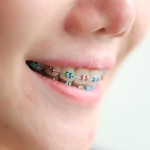
A 2009 systematic review by Lui et al suggested a modest association between malocclusion and poor oral health related quality of life (OHQoL). The aim of this study was to examine the relationships between dental appearance, characteristics of the individual and their environment, and OHQoL in young people over time.
Methods
A convenience sample of children from schools selected to represent areas with both good and poor access to orthodontic services was used. Baseline data (T1) collection was undertaken at age 11-12 years with follow up examination at age 14-15 years (T2). Measures used were OHQoL (CPQ11–14 ISF-16), Child Health Questionnaire Self Esteem measure (CHQ-CF87) Clinical examination assessed Index of Orthodontic Treatment Need (IOTN)] and dental caries. The Index of Multiple Deprivation was used to indicate socio-economic status (SES). Children were excluded at baseline if they had a previous history of orthodontic treatment, were wearing an orthodontic appliance, or they had cleft lip or plate. Patients wearing orthodontic appliances at 3-year review were also excluded.
Results
- There were 374 patients at T1, 300 with full baseline data.
- 258 were available at 3-year follow up
- The Dental Health component of IOTN improved between T1 and T2 in 35% of participant irrespective of orthodontic treatment. There was no change in 39.2%, but it had worsened in 25.8%.
- Only 16.2% of children had completed orthodontic treatment during the 3-year period.
- There was a significant reduction in the total CPQ11-14 ISF-16 score between T1 and T2 (mean difference = 2.0, SD = 8.7; P = 0.003 paired t-test) suggesting that OHQoL improved over time.
- There was also a significant reduction in SE (mean difference = 5.4, SD = 14.9; P < 0.001 paired t-test).
- Multiple linear regression found no significant cross-sectional associations at T1 between OHQoL and SES and self-assessed IOTN.
- There were significant longitudinal associations between the change in OHQoL and change in SE and change in the decayed, missing, or filled surfaces.
- The mean improvement in the total CPQ11-14 ISF-16 score for those with a history of orthodontic treatment was 3.2 (SD = 6.9; P = 0.009) and 2.4 (SD = 8.8; P < 0.001) for those with no history of treatment. The difference was not statistically significant (P = 0.584).
Conclusions
The authors concluded: –
OHQoL improved in young people over time, whether they gave a history of orthodontic treatment or not. Individual and environmental characteristics influence OHQoL and should be taken into account in future studies.
Comments
This was an interesting study that found no association between the change in the OHQoL and a self-reported history of having orthodontic treatment. Although the proportion of children in this sample who had reported orthodontic treatment is lower than anticipated. As the authors note this was a convenience sample rather than a random sample although this a school-based sample rather than a clinic-based sample in contrast to other OHQoL studies. The findings also suggest that those with higher SE have less frequent impacts from their malocclusion and any improvement in OHQoL over time is associated with an increase in SE. a finding which the authors suggests need further investigation.
Links
Benson PE, Da’as T, Johal A, Mandall NA, Williams AC, Baker SR, Marshman Z. Relationships between dental appearance, self-esteem, socio-economic status, and oral health-related quality of life in UK schoolchildren: A 3-year cohort study. Eur J Orthod. 2014 Dec 5. pii: cju076. [Epub ahead of print] PubMed PMID: 25481920.
Liu Z, McGrath C, Hägg U. The impact of malocclusion/orthodontic treatment need on the quality of life. A systematic review. Angle Orthod. 2009 May;79(3):585-91.

Don’t miss – Orthodontic treatment: does it impact on quality of life? http://t.co/pIBcycKSOp #EBP
@TheDentalElf Thanks for your comments on our paper on impact of #malocclusion, self esteem and SES
Don’t miss – Orthodontic treatment: does it impact on quality of life? http://t.co/P1HdzkgEci #EBP via @TheDentalElf